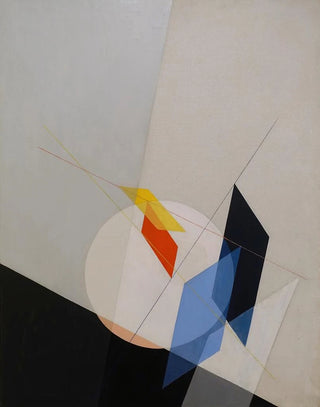Art print | A 18 - László Moholy-Nagy


View from behind

Frame (optional)
Un 18 - László Moholy-Nagy – Captivating Introduction
In the vast panorama of art history, certain works stand out for their ability to transcend time and artistic movements. "Un 18" by László Moholy-Nagy is a shining example. This piece, emblematic of the Bauhaus, embodies the innovative spirit of its creator, a pioneer whose vision redefined the boundaries between art and design. The art print Un 18 - László Moholy-Nagy allows you to explore this fusion of form and function, while offering a window into the visual experimentation that marked the early 20th century. By inviting this piece into your space, you are not just welcoming a work of art, but fostering a dialogue between past and present—a reflection on modern aesthetics.
Style and uniqueness of the work
"Un 18" is distinguished by its bold use of light and geometric shapes. The composition, both dynamic and balanced, reveals an undeniable mastery of visual elements. Moholy-Nagy skillfully plays with contrasts, using vivid colors and clean lines to create a visual tension that captures attention. Each element of the piece seems to dialogue with the others, forming a harmonious whole that evokes a sense of movement and modernity. This style, characterized by thoughtful abstraction, reflects the artist's commitment to experimentation and innovation. "Un 18" is much more than a simple image; it is an invitation to rethink our perception of art and its role in contemporary society.
The artist and his influence
László Moholy-Nagy, a central figure of the Bauhaus movement, left an indelible mark on modern art and design. Born in Hungary, he combined his artistic training with a scientific approach, integrating photographic techniques and industrial materials into his work. Moholy-Nagy believed that art should be accessible and useful, and he worked towards democratizing creativity. His influence extends far beyond his era, inspiring generations of artists, designers, and architects. By redefining the relationships between

Matte finish

View from behind

Frame (optional)
Un 18 - László Moholy-Nagy – Captivating Introduction
In the vast panorama of art history, certain works stand out for their ability to transcend time and artistic movements. "Un 18" by László Moholy-Nagy is a shining example. This piece, emblematic of the Bauhaus, embodies the innovative spirit of its creator, a pioneer whose vision redefined the boundaries between art and design. The art print Un 18 - László Moholy-Nagy allows you to explore this fusion of form and function, while offering a window into the visual experimentation that marked the early 20th century. By inviting this piece into your space, you are not just welcoming a work of art, but fostering a dialogue between past and present—a reflection on modern aesthetics.
Style and uniqueness of the work
"Un 18" is distinguished by its bold use of light and geometric shapes. The composition, both dynamic and balanced, reveals an undeniable mastery of visual elements. Moholy-Nagy skillfully plays with contrasts, using vivid colors and clean lines to create a visual tension that captures attention. Each element of the piece seems to dialogue with the others, forming a harmonious whole that evokes a sense of movement and modernity. This style, characterized by thoughtful abstraction, reflects the artist's commitment to experimentation and innovation. "Un 18" is much more than a simple image; it is an invitation to rethink our perception of art and its role in contemporary society.
The artist and his influence
László Moholy-Nagy, a central figure of the Bauhaus movement, left an indelible mark on modern art and design. Born in Hungary, he combined his artistic training with a scientific approach, integrating photographic techniques and industrial materials into his work. Moholy-Nagy believed that art should be accessible and useful, and he worked towards democratizing creativity. His influence extends far beyond his era, inspiring generations of artists, designers, and architects. By redefining the relationships between






